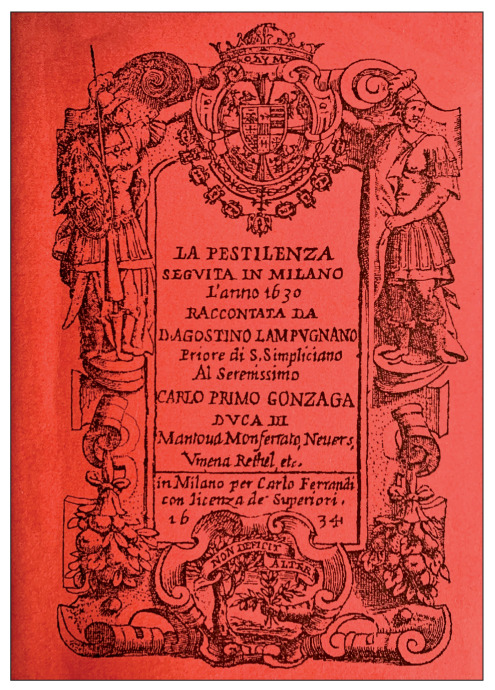Sir,
In western democracies, individual behaviour will be crucial to control the spread of COVID-19, as well as government actions (1) that unfortunately, except China, South Korea and Italy, followed by others, seems to be generally unconvinced and, speculatively, late. Indeed human history has been marked by epidemics/pandemics which have affected, more or less, large geographical areas (2). Italy, as well as the rest of Europe, has often been affected by these phenomena and, Lombardy, due to his position, was, as today by COVID-19, severely stroked in Italy that is, after China, the second most affected country (3). This is also linked to the position of Lombardy and its capital, Milan, but this is beyond this brief comment. There are several differences between the past plagues and the actual COVID-19 pandemic and these must be sought in the increased ability to transmit diseases at-distance through the mobility of humans and goods (4), and in the catastrophic consequences of the breakdown of ecosystems, as told, a few years ago, by David Quammen in the book “Spillover” (5).
Several literary descriptions of the past plagues in Italy are known, one of the most interesting, by analogy with current outbreak in Lombardy, is the plague of 1630 in Milan described by Agostino Lampugnano (6) who was, possibly, the source for Alessandro Manzoni’s description of the plague in Milan in the novel “ I promessi sposi” (The betrothed) of 1840.
What I want to emphasize is that the initial reaction of “humans” to the emergence of COVID-19 has remained, substantially, the same as told by Lampugnano in 1634: “...and if the beginning plague contagion were other?” that is to say “The plague grew by unbelief…” and “stubbornness in bad doing…”; and, again, on the consequences: “Therefore, the little belief on the beginning of the plague, meant that the disease was estimated less than reasonable...and this was the bellows, blowing in the mind of the little shrewd, made to neglect the appropriate remedies”. This is the reason why, even today, despite the ordinance to stay at home, people are seen on the streets in Milan. And the role of physicians? Hard, even in those days, Lampugnano reports that the first physicians who reported the danger of the plague were “insulted on the street” while, possibly today, are considered prophets.
Figure 1.

Lampugnano’s book cover.
Psychologists may say that this is a predictable human reaction, but given that history is studded with these episodes, it would be desirable to reach a general consensus on public health guidelines during pandemics.
Note: in quotes the sentences taken from Lampugnano’s book and translated from seventeenth-century Italian.
Conflict of interest:
Each author declares that he or she has no commercial associations (e.g. consultancies, stock ownership, equity interest, patent/licensing arrangement etc.) that might pose a conflict of interest in connection with the submitted article
References
- 1.Anderson RM, Heesterbeek H, Klinkenberg D, Hollingsworth TD. How will country-based mitigation measures influence the course of the COVID-19 epidemic? (published online ahead of print, 2020 Mar 9) Lancet. 2020;S0140-6736(20):30567–5. doi: 10.1016/S0140-6736(20)30567-5. doi:10.1016/S0140-6736(20)30567-5. [DOI] [PMC free article] [PubMed] [Google Scholar]
- 2.Cipolla Carlo M. Madison: University of Wisconsin Press; 1981. Fighting the Plague in Seventeenth Century Italy. ISBN 0-299-08340-3. [Google Scholar]
- 3.Remuzzi A, Remuzzi G. COVID-19 and Italy: what next. The Lancet: Published online March 12, 2019 https://doi.org/10.1016/S0140-6736(20)30627-9 . [Google Scholar]
- 4.Findlater A, Bogoch II. Human Mobility and the Global Spread of Infectious Diseases: A Focus on Air Travel. Trends Parasitol. 2018;34(9):772–783. doi: 10.1016/j.pt.2018.07.004. doi:10.1016/j.pt.2018.07.004. [DOI] [PMC free article] [PubMed] [Google Scholar]
- 5.David Quammen. New York, New York, USA: W.W. Norton & Company, Ltd; 2012. ISBN: 978-0-393-06680-7. [Google Scholar]
- 6.Lampugnano Agostino. Carlo Ferrandi., editor. (1634), La pestilenza seguita in Milano l’anno. 1630 Reprinted 2002, Ed. La vita Felice, Milan, Italy. ISBN 88-7799-115-1. [Google Scholar]


